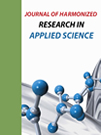Short Communication - (2022) Volume 10, Issue 1
PROTEIN-PROTEIN INTERACTIONS IN DRUG DESIGNING
Karishma Agarwal*Received: Feb 25, 2022, Manuscript No. JHRAS-22-61466; Editor assigned: Feb 28, 2022, Pre QC No. JHRAS-22-61466(PQ); Reviewed: Mar 14, 2022, QC No. JHRAS-22-61466; Revised: Mar 22, 2022, Manuscript No. JHRAS-22-61466(R); Published: Mar 29, 2022, DOI: 10.30876/2321-7456.22.10.01
Description
Protein-protein interactions are increasingly targeted by drug discovery groups, leaving great scope for therapeutic regulation of this class of targets in disease. The sequences of structurally interacting elements in which proteins interact with each other are broad and contrary to a clear classification. However, a wide range of subdivisions can be made by grouping interactions based on the spherical or peptide nature of the protein [1]. Some strategies for developing inhibitors for particular protein-protein interactions may have greater traction in a particular class of Protein-protein interactions than in other classes. For example, fragment-based drug discovery has been shown to be particularly promising when targeting bromodomains, as well as peptide mimetics in β-strand mimetics. Protein-protein interactions are associated with major intracellular activities and pathways, and in this respect are promising targets for drug discovery [2]. But for small molecule drugs, this promise has not been fulfilled. Due to the physical properties of many protein-protein interactions surfaces, they are unable to support the binding of small druglike molecules. In addition, there are other hurdles specific to this class that make the drug development process difficult and dangerous. Nonetheless, success stories are born in this area [3]. These experiences are beginning to provide general strategies and tools to help overcome the inherent problems in pursuing targets for protein-protein interactions. These lessons should improve the success rate if these systems are pursued in the future. Regulation of protein-protein interactions (Protein-protein interctions) is becoming increasingly important in drug discovery and chemical biology. While this “target class” was thought to be almost incurable just a few years ago, an impressive series of publications and success stories actually target PPI with small drug-like molecules. It shows that it is a viable approach. The human proteome is composed of approximately 20,000 proteins and more protein-protein interactions play a central role in biological processes. Their deregulation often leads to the onset and progression of multiple diseases. Therefore, Protein-protein interactions are important for designing disease-modifying drugs, but convert small molecules like drugs into therapeutic drugs, taking into account not only the activity and selectivity of the drug, but also the toxicity associated with the drug. Starting with natural products, the synthesis of small molecules such as new drugs or the design of similar analogs has been attempted to allow optimization of suitable compounds. Chemical modifications starting with the planar marine natural product have identified a non-planar tetrahydro β-carboline analogs with a conserved ability to selectively bind to its target CDK4. The successful design of protein-protein interaction modulators is still a great challenge, and is generally supported by a detailed knowledge of the system at molecular and structural level. Structural and biophysical methods for ligand discovery targeting Protein- protein interactions, supported by the identification and validation of protein-protein complexes, are valuable tools to possibly tackle difficult Protein-protein interactions [4]. With this, X-ray crystallography is essential to successfully assess the structural and mechanistic details of interaction events at atomic resolution, and key for the development of novel Protein-protein interactions modulators [5]. With the resurgence of phenotypic assays in drug discovery, the observations in these systems are often complex as recently shown by cell-cell interactions in stroke models and understanding the nature of the Protein-protein interactions using novel technologies will allow the scientific community to better understand and unveil therapeutically relevant aspects of such Protein-protein interactions to treat a variety of human diseases. Protein-protein interaction predictions are methods used to predict the outcome of pairs or groups of protein interactions. These predictions are done in vivo, and various methods can be used to carry out the predictions. Predicting interactions is important because it helps researchers infer the results of Protein-protein interactions. Protein-protein interactions can be studied, among other things, by evolutionary profiling, identification of structural patterns and homologous pairs, intracellular localization, and post-translational modification [6]. Normally, proteins function in vivo, but rarely as isolated species. It has been found that more than 80% of proteins act in complexes rather than alone. Comprehensive analysis of certified proteins reveals that proteins involved in the same cellular process interact repeatedly.
References
- Bakail M, Ochsenbein F. Targeting protein-protein interactions, a wide open field for drug design. C R Chim. 2016;19(2):19-27.
- Jones S, Thornton JM. Principles of protein-protein interactions. PNAS. 1996;93(1):13-20.
- Phizicky EM, Fields S. Protein-protein interactions: Methods for detection and analysis. Microbiol Rev.1995;59(1):94-123.
[Crossref] [Google Scholar] [PubMed]
- Russell RB, Alber F, Aloy P, Davis FP, Korkin D, Pichaud M, et al. A structural perspective on protein-protein interactions. Curr Opin Struct Biol. 2004;14(3):313-324.
[Crossref] [Google Scholar] [PubMed]
- Waugh DF. Protein-protein interactions. Adv Protein Chem. 1954;9:325-437.










